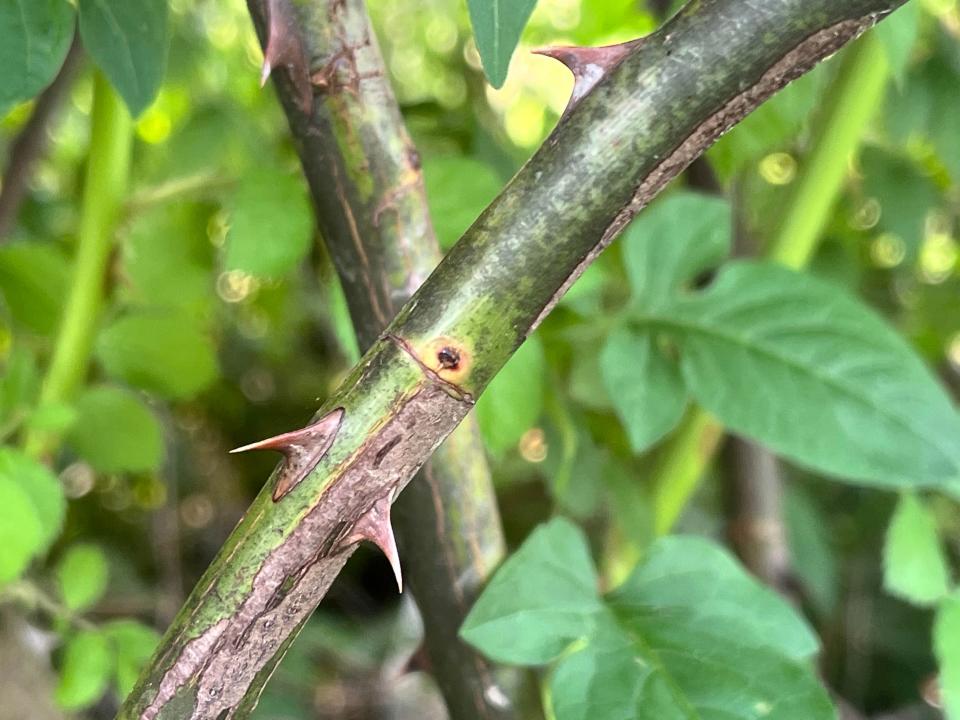Conservation Corner: A real thorn in the side
I’ve heard thorns called many things. Spikes, spines, bristles, prickles, stickers, barbs, and prongs are some of the terms people may use to describe the sharp and pointy projections that can be found growing on certain plant stems and leaves. When encountered on an otherwise enjoyable hike, an outburst of rather crude adjectives might even be heard preceding those names if said hiker has the misfortune of their skin being pierced by one or more of them. Those of us who have first-hand experience dealing with thorns may find them an irritating nuisance, but for plants, they are an important defensive adaptation that evolved over thousands of years.

There is an oft-quoted Law of Nature that simplifies survival into just four words; “Eat or be eaten.” Unfortunately for plants, they tend to find themselves relating to the latter part of that phrase unless they have developed some physical or chemical means to make their parts less palatable to herbivores. Thorns fall into the physical deterrent category and are quite effective at preventing browse damage from animals that eat using only their mouths without the benefit of opposable thumbs and steel utensils. They are found on a variety of plant types and can come in a host of different sizes and shapes. The location and process by how thorns are formed by the plant are also used to determine the scientific term botanists use to describe them.
True thorns are generally found on woody shrubs and trees and are created as a modified branch structure. Some familiar trees found in Ohio, such as hawthorn and callery pear, have imposing true thorns that line their branches and twigs and can grow several inches in length. Those who have visited fruit groves in more southern states may have experienced similar pointed growths on most of the commercially grown citrus trees such as lemon, orange, and grapefruit.
The term “spine” is used to describe sharp projections constructed out of modified leaf tissue, even though many can be as formidable, or more so, as the true thorns listed above. Spines occur on possibly the widest range of plant types that includes everything from herbaceous annuals to towering trees. Perhaps, the most well-known example of this globally would be the myriad species of cactuses. Virtually lacking anything resembling a typical leaf, this group of plants went all-in on spine production instead. Spines may grow independently along the stem or be produced as spiky margins of traditional leaves like we see with Canada thistle and American holly. And, if there were such a thing as an undisputed heavyweight champion of spine production in Ohio, it would undoubtedly be the honey locust. Not only does this tree produce spines that can reach nearly twelve inches long, but there are even spines growing out of other spines, and all are strong enough to puncture automobile and tractor tires!
The last thorn-like adaptation, known as a “prickle,” typically grows along the stem and is derived from the epidermal or bark tissue. While this term may sound almost endearing, anyone who has ripped a pair of pants or been left bleeding after stumbling into a patch of multiflora rose will likely have less than pleasant feelings. Prickles are typical of most plants we think of as briars or brambles and include both native and cultivated rose varieties, blackberries, raspberries and greenbriers. The most imposing of Ohio’s native prickle-bearers might be the aptly named devil’s walking stick which has its stem ringed with a circle of spines at each leaf scar.
Whether you call them by their technical terms or use an all-inclusive phrase, it pays to keep an eye out for these adapted plants on your walk through the woods, so they don’t become a thorn in your side.
This article originally appeared on Lancaster Eagle-Gazette: Conservation Corner: A real thorn in the side

